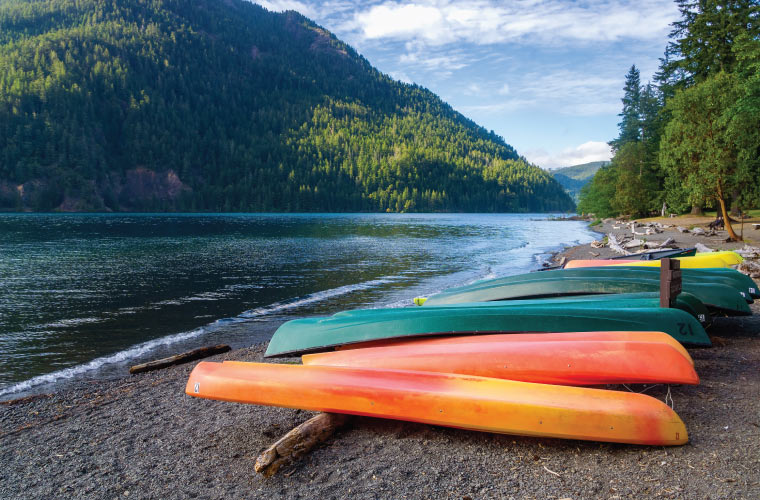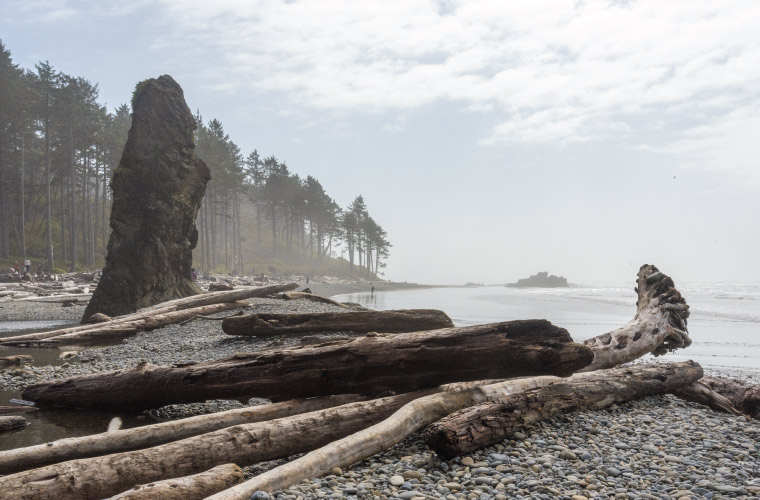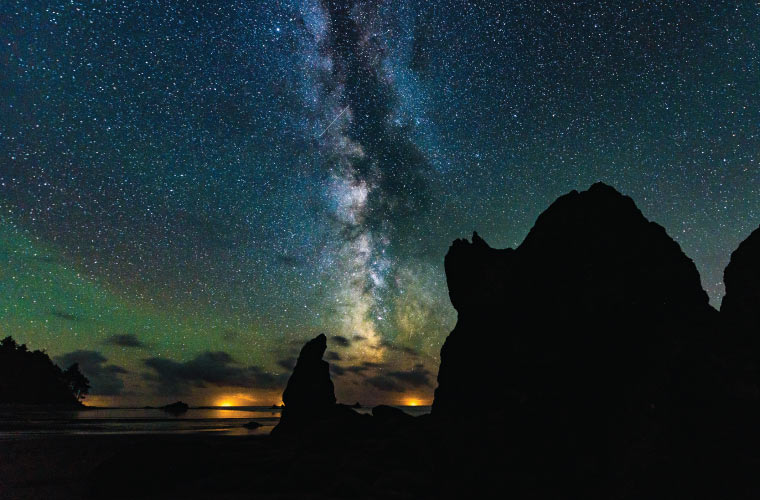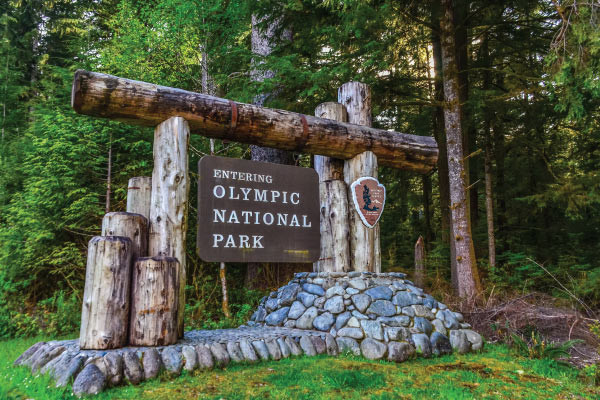Insider's Guide to Olympic National Park
Posted by Douglas Scott on 28th Jul 2021
There are few places in the world with the diversity, beauty, and wilderness of Olympic National Park. Olympic is a temperate rainforest that receives 14 feet of rain each year. Forests drip with water and moss as herds of elk stroll along salmon-filled rivers. It is 73 miles of undeveloped wilderness coast, rugged and wild. Pass ancient sea stacks standing guard along the untouched coast while mountains loom in the distance.
Olympic is home to mountain ranges over 6,000 feet, where mountain goats roam across hundreds of glaciated peaks before leaving the snow and wandering along endless alpine wonderlands full of shimmering lakes. Olympic has over 3,000 miles of rivers and streams, numerous lakes of all sizes, shapes, and colors — not to mention one of the most gorgeous waterfalls anywhere in the nation.
Consisting of nearly one million acres of the most pristine natural beauty your eyes will ever see, the park is also 95% wilderness and is the ideal destination for hikers and campers of all levels and abilities. The park was initially created as Mount Olympus National Monument by Theodore Roosevelt in 1909, later becoming Olympic National Park in 1938, decreed by Franklin Roosevelt. Since then, the park has grown larger, becoming an International Biosphere Reserve and a World Heritage Site. With wilderness acreage the size of Rhode Island, Olympic National Park leaves visitors in awe with the endless beauty around every corner, jaw-dropping sunsets, and romance of wilderness.

Classic Adventures
Olympic National Park has 611 miles of trails to explore, taking day hikers and backpackers to some of the most beautiful, remote, and stunning sights in the country. The classic and most traveled hikes of Olympic National Park are mostly located on the north and western sides of the region. Out along the Hoh River, a stroll through the Hoh Rainforest on either the Hall of Mosses Trail or the Hoh River Trail will grant you access to America’s most-iconic rainforest scenes. Full of elk and huge stands of old growth timber, hiking any of the trails in the Hoh leads you to cathedrals of moss and ferns. Want to avoid the summer crowds along the Hall of Mosses Trail? Head up the Hoh River Trail until you reach a tiny wooden bridge with views of Mineral Creek Falls.
Out on the Coast, just an hour’s drive from the Hoh Rainforest, the beaches of LaPush await adventure. Offering miles of beach hiking to stunning sea stacks and amazing tide pools, LaPush is best known for Rialto Beach and Hole in the Wall, an outcropping of land that has been eroded into a giant, truck-sized hole by the ever-pounding waves of the mighty Pacific Ocean. Further south, a lesser-visited beach is Second Beach. Don’t let the lack of creativity in the name fool you, Second Beach is absolutely breathtaking and has even more iconic sea stacks that make spending the day and enjoying a sunset there a memory that will stay with you forever.
Up on the northern flank of Olympic National Park, the Lake Crescent region gives amazing access to waterfalls, hiking trails, and mountains to climb, all within a few miles drive from the Lake Crescent Lodge. Families will enjoy the Spruce Railroad Trail and the amazing bridge spanning the Devil’s Punchbowl, while more adventurous types will have fun scaling the rocky summit of Mount Storm King. Close to Lake Crescent, waterfall lovers will delight in hiking the short trail to Sol Duc Falls, just a few miles from Sol Duc Hot Springs.
Once you have seen the rivers, lakes, rainforests, and coast of Olympic, a jaunt up to Hurricane Ridge will leave you in awe of the expansive vistas from Olympic National Park’s ridge lines. Numerous trails branch out from the visitor center, but the two highlights are the trek to Hurricane Hill or a walk along Klahhane Ridge to another panoramic wonderland. In the summer, the region erupts with wildflowers, as marmots and mountain goats scatter about. With glaciers visible and lush forest valleys 5,000 feet below, Hurricane Ridge will leave you longing for more days of exploration.
Secrets of the Park

Hiding behind the popular areas of Olympic National Park, entire valleys and mountain ridges await discovery for those who want solitude in wilderness. The best of the lesser-visited regions of Olympic can be found along the eastern side of the park near Hood Canal. The most developed of these regions is Staircase, which offers access to backpacking, mountain climbing, and family-friendly hikes all along the Skokomish River Valley. Highlights of this region include the short Staircase Loop Trail, the panoramic views of Cub Peak, and the majestic wilderness found above Flapjack Lakes at Gladys Divide. Along the Hamma Hamma River, trails from Olympic National Forest lead to stunning destinations like Upper Lena Lake and the fantastically-gorgeous Lake of the Angels. Those looking for more of a secret area closer to popular destinations like Hurricane Ridge, head toward the town of Sequim and drive up to Deer Park. This high alpine campground gives spacious views as well as access to miles of trails along ridges and into isolated river valleys.
Immerse Yourself
Most of Olympic National Park’s beauty is hidden from the average visitor. The majority of the park’s 611 miles of trails rarely get seen by the millions who visit the park each year. Backpacking in Olympic is special and is one of the best ways to see the purity of the 700,000+ acres of wilderness. While you can crisscross the Olympics on dozens of trails, there are four backpacking trips that need to be experienced. The first is Seven Lakes Basin, located out of the Soul Duc Region. Best seen in the early summer or early fall months, this 19 mile loop gains 4,000 feet of elevation, leading to impressive views of the Olympic Interior while skirting high alpine lakes frequented by mountain goats.
Those looking to enjoy coastal views should head out to Shi Shi Beach and Point of the Arches. Located at the northern-most stretches of the coastal wilderness region of Olympic, this area gives access to 73 untouched miles of coastline and lets you hike along the most stunning display of sea stacks imaginable. For rainforest backpacking, two trails lead you to some of the greenest and most magical places in the country. The first is the Hoh River Trail, which runs all the way up to the glaciers of Mount Olympus. As a 35 mile out and back trail, the route is mostly flat for 13 miles before rising up the ridge leading to the Olympic Mountains’ tallest summit. Watch for elk, black bear and occasional mountain goats along this trail. Another great backpacking trip is the trek to the Enchanted Valley of the Quinault Rainforest. This 30 mile out and back trail leads you through a magical stretch of forest before emptying you out next to the Enchanted Valley Chalet along the Quinault River. With mountains looming large to the north, this popular hike offers great views and a chance to see black bear.

Get the Most Out of Your Visit
- Only the Kalaloch Campground accepts reservations; every other campsite is first come, first serve.
- Numerous roads are prone to washouts and access to certain areas may be limited. Please check with local experts or the National Park itself to see if your trip will be impacted.
- Shi Shi Beach has the absolute best sunsets in Olympic National Park, but an easier to get to destination that is just as stunning is Ruby Beach
- Don’t try to see the park in one or two days. For the best experience, you will need at least 3 days, with 5 being ideal.
- On summer weekends, the main areas of the park can become quite crowded. Arrive early or head out to one of the lesser visited spots
- There are no roads crossing the park; only Highway 101 loops around the region. It will take half a day of non-stop driving to circle the park.
Written by Douglas Scott for RootsRated and legally licensed through the Matcha publisher network. Please direct all licensing questions to legal@getmatcha.com.
Share on:

